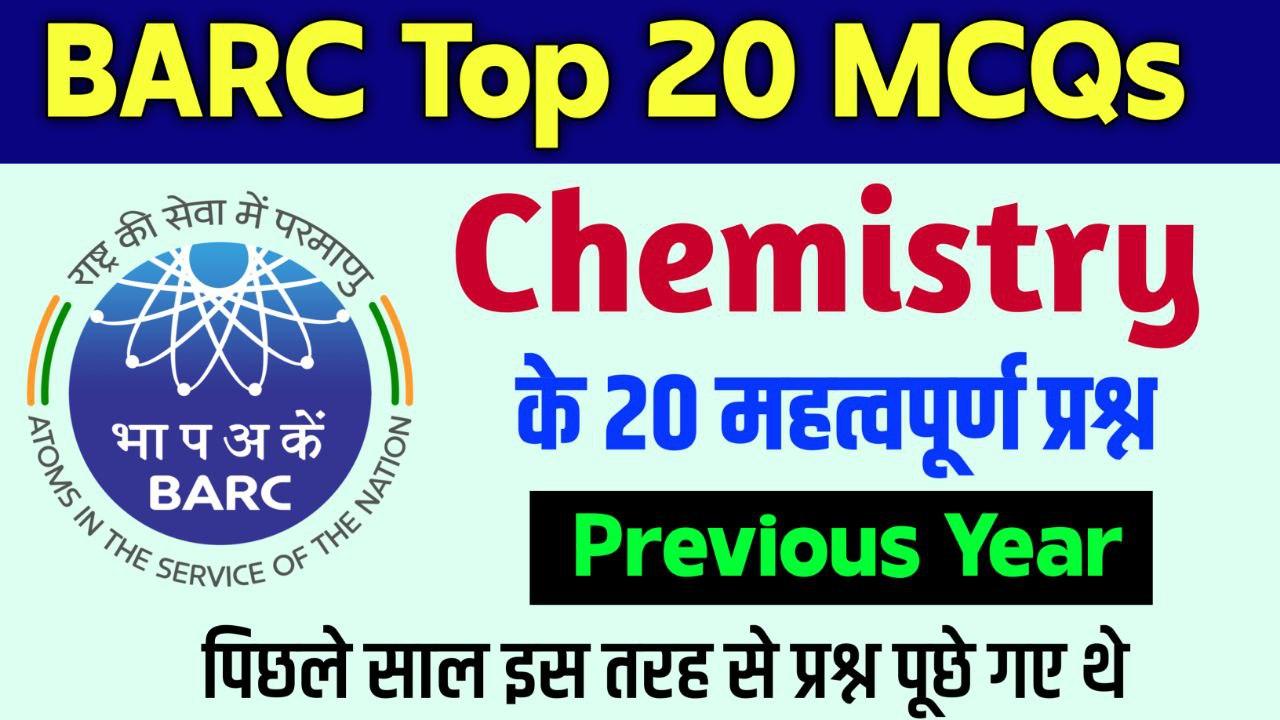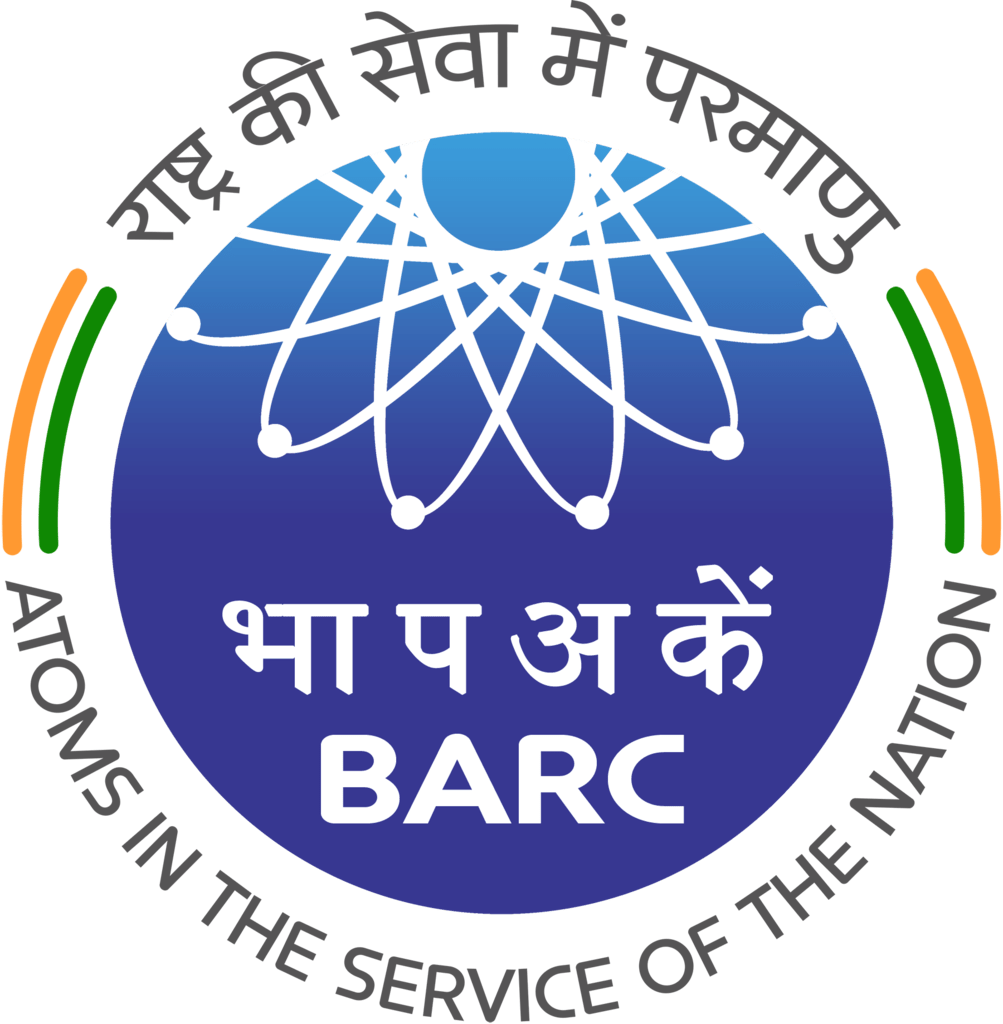BARC Previous Year Question Paper
BARC Practice Set- 05
Chemistry Top-20 MCQs
यह Practice Set BARC के Exam को ध्यान में रख कर पिछले वर्षों में पूछे गए प्रश्नों के आधार पर तैयार किया गया। इसकी सहायता से आप अपने BARC Exam की तैयारी को और भी शानदार बना सकते हैं।
Que 01. ब्राउनियन गति की खोज किसने की थी?
(a) आइजैक न्यूटन
(b) मेंडल ब्राउन
(c) रॉबर्ट ब्राउन
(d) जॉन ब्राउन
Que 01. Who discovered Brownian motion?
(a) Isaac Newton
(b) Mendel Brown
(c) Robert Brown
(d) John Brown
Que 02. बेंजीन के एक अणु में …… दोहरे आबंध होते हैं।
(a) 3
(b) 2
(c) 4
(d) 1
Solution यहाँ देखें 👉 Click Here
Que 02. A molecule of benzene has …… double bonds.
(a) 3
(b) 2
(c) 4
(d) 1
Que 03. सल्फर की परमाणुकता क्या है?
(a) बहु-परमाणुक
(b) द्विपरमाणुक
(c) एकपरमाणुक
(d) त्रिपरमाणुक
Que 03. What is the atomicity of sulphur?
(a) Polyatomic
(b) Diatomic
(c) Monoatomic
(d) Triatomic
Que 04. लैंथेनाइड्स और एक्टिनाइड्स को …….. भी कहा जाता है।
(a) आंतरिक संक्रमण तत्त्व
(b) अक्रिय गैस
(c) सामान्य तत्व
(d) संक्रमण तत्त्व
Que 04. Lanthanides and actinides are also called ………
(a) Internal transition element
(b) Inert gas
(c) Common element
(d) Transition element
Que 05. कार्यात्मक समूह -CHO निम्नलिखित में से किसमें मौजूद होता है?
(a) कीटोन
(b) एल्डिहाइड
(c) एल्कोहल
(d) कार्बोक्सिलिक अम्ल
Que 05. The functional group -CHO is present in which of the following?
(a) Ketone
(b) Aldehyde
(c) Alcohol
(d) Carboxylic acid
Que 06. P4O10 + H2O → H3PO4 समीकरण पर ध्यान दें। अभिक्रिया में जल के आवश्यक कण होगें।
(a) 2
(b) 6
(c) 8
(d) 4
Solution यहाँ देखें 👉 Click Here
Que 06. Pay attention to the equation P4O10 + H2O → H3PO4. There will be essential particles of water in this reaction.
(a) 2
(b) 6
(c) 8
(d) 4
Que 07. बैकेलाइट होता है एक ….
(a) रोधक (इन्सुलेटर)
(b) सेमीकंडक्टर
(c) उच्च प्रतिरोधी चालक
(d) निम्न प्रतिरोधी चालक
Que 07. Bakelite is a ….
(a) Insulator
(b) Semiconductor
(c) High resistance conductor
(d) Low resistance conductor
Que 08. फेन प्लवन विधि में, अयस्क के चूर्ण को ……. के मिश्रण से भरी एक टंकी में रखा जाता है।
(a) जल और एल्युमिनियम
(b) जल एवं चीड़ का तेल
(c) ताबा और जल
(d) जल और वनस्पति तेल
Que 08. In the froth floatation method, ore powder is placed in a tank containing the mixture.
(a) Water and aluminum
(b) Water and pine oil
(c) Copper and water
(d) Water and vegetable oil
Que 09. गैलेना किसका अयस्क है?
(a) सीसा
(b) तांबा
(c) एल्युमीनियम
(d) लोहा
Solution यहाँ देखें 👉 Click Here
Que 09. Whose ore is Galena?
(a) Lead
(b) Copper
(c) Aluminum
(d) Iron
Que 10. हथेली पर रखने पर निम्न में कौन सा पिघल जाएगा?
(a) Cs और Na
(b) Ga और Cs
(c) Na और Ga
(d) Li और Na
Que 10. Which of the following will melt when placed on the palm?
(a) Cs and Na
(b) Ga and Cs
(c) Na and Ga
(d) Li and Na
Que 11. एक्टिनियम की परमाणु संख्या है-
(a) 89
(b) 90
(c) 88
(d) 91
Que 11. The atomic number of actinium is-
(a) 89
(b) 90
(c) 88
(d) 91
Que 12. N की परमाणु संख्या 7 है, फिर नाइट्रोजन परिवार के तीसरे तत्व की परमाणु संख्या है-
(a) 13
(b) 25
(c) 35
(d) 33
Que 12. The atomic number of N is 7, then the atomic number of the third element of the nitrogen family is-
(a) 13
(b) 25
(c) 35
(d) 33
Que 13. 27°C तापमान पर स्थित किसी आदर्श गैस को एक नियत दाब पर तब तक गर्म किया जाता है जब तक कि इस गैस का आयतन दोगुना ना हो जाए। गैस का अंतिम तापमान होगा:
(a) 54°C
(b) 327°C
(c) 108°C
(d) 654°C
Solution यहाँ देखें 👉 Click Here
Que 13. An ideal gas at a temperature of 27°C is heated at a constant pressure until the volume of the gas doubles. The final temperature of the gas will be:
(a) 54°C
(b) 327°C
(c) 108°C
(d) 654°C
Que 14. हाइड्रोजन के समस्थानिक, ड्यूटेरियम में ……. होते हैं।
(a) शून्य न्यूट्रॉन और एक प्रोटॉन
(b) एक प्रोटॉन और एक न्यूट्रॉन
(c) एक इलेक्ट्रॉन और दो न्यूट्रॉन
(d) एक न्यूट्रॉन और दो प्रोटॉन
Que 14. Deuterium, an isotope of hydrogen, has ……..
(a) Zero neutrons and one proton
(b) One proton and one neutron
(c) One electron and two neutrons
(d) One neutron and two protons
Que 15. हाइजेन्बर्ग के अनिश्चितता के सिद्धान्त में, संवेग की अनिश्चितता और एक कण की स्थिति को
(a) खोज प्रकाश के छोटे तरंग दैर्ध्य का उपयोग कर घटाया जा सकता है
(b) खोज प्रकाश के बड़े तरंग दैर्ध्य का उपयोग कर घटाया जा सकता है
(c) सैक्लोट्रॉन द्वारा त्वरित उच्च ऊर्जा जॉच कणों का उपयोग का घटाया जा सकता है
(d) घटाया नहीं जा सकता क्योंकि वह मौलिक रूप से अन्तर्निष्ठ है
Que 15. In Heisenberg’s uncertainty principle, the uncertainty of momentum and position of a particle
(a) can be reduced by using shorter wavelength of search light
(b) can be reduced by using longer wavelength of search light
(c) the use of high energy probe particles accelerated by cyclotrons can be reduced
(d) cannot be deduced as it is fundamentally inherent
Que 16. एक इलेक्ट्रॉन में ऋणात्मक आवेश होता है।
(a) 1.6 × 10+18C
(b) 1.6 x 10-16C
(c) 1.6 x 10-18C
(d) 1.6 x 10-19C
Que 16. An electron has a negative charge.
(a) 1.6 × 10+18C
(b) 1.6 x 10-16C
(c) 1.6 x 10-18C
(d) 1.6 x 10-19C
Que 17. दो या दो से अधिक रूपों में किसी तत्व का होना जिसमें भौतिक गुण भिन्न लेकिन रासायनिक गुण समान होते हैं क्या कहलाता है ?
(a) श्रृंखलन
(b) अल्काइन
(c) अपरूपता
(d) अल्केन
Que 17. What is the presence of an element in two or more forms in which physical properties are different but chemical properties are similar?
(a) concatenation
(b) Alkyne
(c) Allotropy
(d) alkane
Que 18. एक रासायनिक अभिक्रिया के दौरान, अभिक्रियाओं और उत्पादों के द्रव्यमानों का योग अपरिवर्तित रहता है इसे क्या कहा जाता है?
(a) निश्चित अनुपात का नियम
(b) ऊर्जा संरक्षण का सिद्धांत
(c) रासायनिक संयोजन का नियम
(d) द्रव्यमान संरक्षण का सिद्धांत
Que 18. During a chemical reaction, the sum of the masses of reactants and products remains unchanged what is it called?
(a) Law of definite proportion
(b) Principle of conservation of energy
(c) Law of chemical combination
(d) Principle of conservation of mass
Que 19. अभी तक वैज्ञानिकों द्वारा पदार्थ की कितनी अवस्थाएं तय की गयी हैं?
(a) 2
(b) 5
(c) 4
(d) 3
Solution यहाँ देखें 👉 Click Here
Que 19. How many states of matter have been determined by scientists so far?
(a) 2
(b) 5
(c) 4
(d) 3
Que 20. मिश्रण प्रकृति में …. हो सकता है।
(a) समांगी
(b) विषमांगी
(c) समांगी और विषमांगी दोनों
(d) शुद्ध पदार्थ
Que 20. A mixture can be ……… in nature.
(a) homogenous
(b) heterogeneous
(c) both homogeneous and heterogeneous
(d) pure substance
Solution यहाँ देखें 👉 Click Here
| Important Link |
|
| Solution | Watch |
| Download | |
| BARC Telegram Group | Join Now |
| BARC Whatsapp Group | Join Now |
| Other Practice Set | Click Here |
| BARC Classes Playlist | Click Here |
| YouTube | Subscribe |






